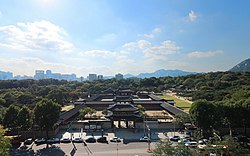

| Changgyeonggung | |
|---|---|

View of the palace in 2014
| |
 | |
| General information | |
| Town or city | Jongno District, Seoul |
| Country | South Korea |
| Coordinates | 37°34′42″N 126°59′46″E / 37.57843°N 126.99598°E / 37.57843; 126.99598 |
| Website | |
| english | |
| Changgyeonggung | |
| Hangul | 창경궁 |
|---|---|
| Hanja | |
| Revised Romanization | Changgyeonggung |
| McCune–Reischauer | Ch'anggyŏnggung |
Changgyeonggung (Korean: 창경궁; lit. Changgyeong Palace) is a palace located in Seoul, South Korea.
The palace was built in the mid-15th century by King Sejong for his father, Taejong. It was originally named "Suganggung", but it was renovated and enlarged in 1483 by King Seongjong, at which time it received its current name. Many structures were destroyed during Japan's multiple late 15th to 16th (1592) century attempts to conquer Korea and invade China. It was rebuilt by successive Joseon Kings but was once again largely destroyed by the Japanese in the early 20th century. This time, it was torn down methodically to make room for a modern park, a showplace for the empire, akin to Tokyo's Ueno Park.
During the Japanese colonial period, the Japanese built a zoo, botanical garden, and museum on the site. It was called "Changgyeongwon park", the "won" standing for the Korean word 'zoo'. After independence in 1945 and the turmoil and destruction of the 1950-53 Korean War, the zoo was restocked through donations of wealthy Koreans as well as gifts from foreign zoos.[1] In 1983, the zoo and botanical garden were relocated to present-day Seoul Grand Park.
Today its main points of interest are as follows:
On May 13, 1762, that courtyard in front of Munjeongjeon witnessed the most tragic incident of the century. It had been reported to King Yeongjo that Crown Prince Sado was mentally ill and behaving erratically. Furious with the Prince, his father ordered him to be sealed alive in a large rice chest, where he died eight days later at the age of 27. King Yeongjo later became remorseful and gave his son the posthumous title 'Sado' ("thinking in sorrow"). It is often believed that Crown Prince Sado was a victim of a conspiracy by his political adversaries, but this is rebutted in the Memoirs of Lady Hyegyeong, which was written by Prince Sado's wife Lady Hyegyeong.
37°34′42″N 126°59′46″E / 37.57843°N 126.99598°E / 37.57843; 126.99598
| Authority control databases: National |
|
|---|